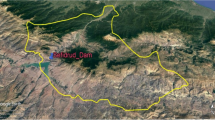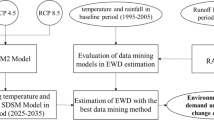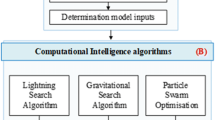Abstract
The prediction of urban water consumption is of great significance for urban planning and management, addressing water demand conflicts among various industries in a city and balancing supply and demand. The prediction of future data by data-driven models is largely based on the assumption of data consistency. However, large-scale human migration, the rapid development of economic activity, climate change and other factors affect the consistency of urban water consumption data, thus creating challenges for traditional data-driven models. In response, a combined prediction model based on the new information priority theory (CPMBNIP) is proposed to predict urban water consumption in a changing environment. To represent the linear and nonlinear characteristics of the urban water consumption system, the autoregressive moving average (ARMA) model and gray model (GM(1,1)) are selected as basic models. Based on the prediction results of the basic models, an optimization model with the corresponding weights of the two basic models as the decision variables is constructed. The optimization model is solved using the nondominated sorting genetic algorithm II (NSGA II) to obtain the set of weight combinations. Based on the principle of new information priority, the final weight combination is selected from the weight combination set according to the criterion of the best fit with the verification set. The final weight combination is incorporated into the two basic models to obtain CPMBNIP and predict the data for the test set. Based on urban water consumption sequence data from six lower-tier cities in southern China from 1965 to 2004, the urban water consumption of these six cities from 2005 to 2013 is predicted by CPMBNIP. Additionally, CPMBNIP is compared with two basic models (ARMA and GM(1,1)) and a single-objective combined prediction model (SOCPM). The percentage errors of CPMBNIP for the six cities' test sets are 4.54%, 3.88%, 6.14%, 4.34%, 3.01% and 3.43%. The prediction effect of CPMBNIP for the test set is better than that of the other models. The results show that CPMBNIP yields the best prediction performance. In addition, compared with the other models, CPMBNIP can better use the information provided by the new data to improve the prediction of some nonstationary time series. This study provides support for urban water consumption prediction under changing environments.







Similar content being viewed by others
Data Availability
The authors have restrictions on sharing data publicly.
References
Amin MM, Dorra EM, Hosny OA (2023) Optimization of Urban Water Consumption in Residential Buildings. Sustainability 15(10):7952
Amos A, Yskandar H, Adnan AM, Ezio T (2017) Overview, comparative assessment and recommendations of forecasting models for short-term water demand prediction. Water 9(11):887
Ashu AB, Lee SI (2021) The effects of climate change on the reuse of agricultural drainage water in irrigation. KSCE J Civ Eng 25(3):1116–1129. https://doi.org/10.1007/s12205-021-0004-2
Bai Y, Wang P, Li C, Xie JJ, Wang Y (2014) A multi-scale relevance vector regression approach for daily urban water demand forecasting. J Hydrol 517:236–245. https://doi.org/10.1016/j.jhydrol.2014.05.033
Bata MH, Carriveau R, Ting DSK (2020) Short-term water demand forecasting using nonlinear autoregressive artificial neural networks. J Water Resour Plan Manag 146(3):04020008. https://doi.org/10.1061/(asce)wr.1943-5452.0001165
Box GEP, Jenkins GM, Reinsel GC (1994) Time series analysis: Forecasting and control. Prentice Hall, Englewood Cliffs, New Jersey
Chelidze T et al (2019) Complex dynamics of fault zone deformation under large dam at various time scales. Geomech Geophys Geo-Energy Geo-Resour 5(4):437–455. https://doi.org/10.1007/s40948-019-00122-3
Chen LX, Mu TY, Li XT, Dong JC (2022) Population prediction of Chinese prefecture-level cities based on multiple models. Sustainability 14(8):1–23. https://doi.org/10.3390/su14084844
Chen GQ, Long TY, Bai Y, Zhang J (2019) A forecasting framework based on kalman filter integrated multivariate local polynomial regression: Application to urban water demand. Neural Process Lett 50(1):497–513. https://doi.org/10.1007/s11063-019-10001-3
Chen GQ, Long TY, Xiong JG, Bai Y (2017) Multiple random forests modelling for urban water consumption forecasting. Water Resour Manag 31(15):4715–4729
Clemen RT (1989) Combining forecasts: A review and annotated bibliography. Int J Forecast 5(4):559–583. https://doi.org/10.1016/0169-2070(89)90012-5
Del Giudice D, Reichert P, Bares V, Albert C, Rieckermann J (2015) Model bias and complexity - Understanding the effects of structural deficits and input errors on runoff predictions. Environ Model Softw 64:205–214
Dong YL, Zhang XM, Deng MX, Huang SW, Mei SW (2019) Research on power prediction of photovoltaic electric field based on grey model. Chin Control Conf (CCC) 7(3):7120–7125. IEEE
Donkor EA, Mazzuchi TA, Soyer R, Roberson JA (2014) Urban water demand forecasting: Review of methods and models. J Water Resour Plan Manag 140(2):146–159. https://doi.org/10.1061/(asce)wr.1943-5452.0000314
Froelich W (2015) Forecasting daily urban water demand using dynamic gaussian bayesian network. Commun Comput Inf Sci 521:333–342
Gao M, Mo DY, Wu XQ (2016) Nonstationary modeling of extreme precipitation in China. Atmos Res 182:1–9. https://doi.org/10.1016/j.atmosres.2016.07.014
Haque MM, de Souza A, Rahman A (2017) Water demand modelling using independent component regression technique. Water Resour Manag 31(1):299–312
Haznedar B, Kilinc HC, Ozkan F, Yurtsever A (2023) Streamflow forecasting using a hybrid LSTM-PSO approach: the case of Seyhan Basin. Nat Hazards 117(1):681–701. https://doi.org/10.1007/s11069-023-05877-3
Herrera M, Torgo L, Izquierdo J, Perez-Garcia R (2010) Predictive models for forecasting hourly urban water demand. J Hydrol 387(1–2):141–150. https://doi.org/10.1016/j.jhydrol.2010.04.005
Hu S, Gao J, Zhong D, Deng L, Ou C, Xin P (2021) An innovative hourly water demand forecasting preprocessing framework with local outlier correction and adaptive decomposition techniques. Water 13(5):582. https://doi.org/10.3390/w13050582
Huang L, Zhang C, Peng Y, Zhou H (2014) Application of a combination model based on wavelet transform and KPLS-ARMA for urban annual water demand forecasting. J Water Resour Plan Manag 140(8):04014013.1–04014013.10
Hyun-Han K, Kim M-G, Kim O (2012) A development of water demand forecasting model based on wavelet transform and support vector machine. J Korea Water Resour Assoc 45(11):1187–1199
Kang HS et al (2015) Optimization of pumping schedule based on water demand forecasting using a combined model of autoregressive integrated moving average and exponential smoothing. Water Sci Technol-Water Supply 15(1):188–195. https://doi.org/10.2166/ws.2014.104
Li H (2021) Time works well: Dynamic time warping based on time weighting for time series data mining. Inf Sci 547:592–608. https://doi.org/10.1016/j.ins.2020.08.089
Li J, Liu CY, Tang L (2022a) Forecast of regional water demand based on NSGAII-FORAGM. Water Supply 22(2):1889–1904. https://doi.org/10.2166/ws.2021.309
Li J, Song S, Guo T, Wang X (2020) Prediction of agricultural water consumption based on fractional grey model. Nongye Gongcheng Xuebao/Trans Chin Soc Agric Eng 36(4):82–89. https://doi.org/10.11975/j.issn.1002-6819.2020.04.010
Li J, Song S, Kang Y, Wang H, Wang X (2021) Prediction of urban domestic water consumption considering uncertainty. J Water Resour Plan Manag 147(3):0502002. https://doi.org/10.1061/(asce)wr.1943-5452.0001329
Li KL, Xiong PP, Wu YR, Dong Y (2022b) Forecasting greenhouse gas emissions with the new information priority generalized accumulative grey model. Sci Total Environ 807. https://doi.org/10.1016/j.scitotenv.2021.150859
Lian YN, Luo JG, Wang JM et al (2022) Climate-driven Model Based on Long Short-Term Memory and Bayesian Optimization for Multi-day-ahead Daily Streamflow Forecasting. Water Resour Manag 36(1):21–37. https://doi.org/10.1007/s11269-021-03002-2
Liang Z et al (2019) An improved chaos similarity model for hydrological forecasting. J Hydrol 577:123953. https://doi.org/10.1016/j.jhydrol.2019.123953
Lifeng W, Sifeng L (2011) Modeling GM(1,1) based new information principle. 2011 IEEE International Conference on Grey System and Intelligent Services Joint with the 15th WOSC International Congress on Cybernetics and System 2011:324–329
Liu GZ, Yuan MK, Chen XD, Lin XK, Jiang QQ (2022) Water demand in watershed forecasting using a hybrid model based on autoregressive moving average and deep neural networks. Environ Sci Pollut Res. https://doi.org/10.1007/s11356-022-22943-8
Liu X, Sang XF, Chang JX, Zheng Y (2021) Multi-model coupling water demand prediction optimization method for megacities based on time series decomposition. Water Resour Manag 35(12):4021–4041. https://doi.org/10.1007/s11269-021-02927-y
Marquardt DW (1963) An algorithm for least-squares estimation of non-linear parameters. Journal of the Society for Industrial and Applied Mathematics 11(2):431–441
Namavar M, Moghaddam MRA, Shafiei M (2023) Developing an indicator-based assessment framework for assessing the sustainability of urban water management. Sustain Prod Consum 40:1–12
Pandey P, Bokde ND, Dongre S, Gupta R (2021) Hybrid Models for Water Demand Forecasting. J Water Resour Plan Manag 147(2):123–134
Peng H, Wu H, Wang J (2020) Research on the prediction of the water demand of construction engineering based on the BP neural network. Adv Civil Eng 2020:8868817. https://doi.org/10.1155/2020/8868817
Qu ZX et al (2017) Research and application of ensemble forecasting based on a novel multi-objective optimization algorithm for wind-speed forecasting. Energy Convers Manag 154:440–454. https://doi.org/10.1016/j.enconman.2017.10.099
Rajballie A, Tripathi V, Chinchamee A (2022) Water consumption forecasting models - a case study in Trinidad (Trinidad and Tobago). Water Supply 22(5):5434–5447. https://doi.org/10.2166/ws.2022.147
Sardinha-Lourenco A, Andrade-Campos A, Antunes A, Oliveira MS (2018) Increased performance in the short-term water demand forecasting through the use of a parallel adaptive weighting strategy. J Hydrol 558:392–404
Sebri M (2016) Forecasting urban water demand: A meta-regression analysis. J Environ Manage 183:777–785. https://doi.org/10.1016/j.jenvman.2016.09.032
Shirisha P, Reddy KV, Pratap D (2019) Real-time flow forecasting in a watershed using rainfall forecasting model and updating model. Water Resour Manag 33(14):4799–4820
Slater LJ et al (2021) Nonstationary weather and water extremes: a review of methods for their detection, attribution, and management. Hydrol Earth Syst Sci 25(7):3897–3935. https://doi.org/10.5194/hess-25-3897-2021
Standaert M (2010) Nearly two-thirds of China’s cities face water deficit, costing $29 billion per year. Inte Environ Rep 33(7):344
Stefanakos CN, Vanem E (2018) Nonstationary fuzzy forecasting of wind and wave climate in very long-term scales. J Ocean Eng Sci 3(2):144–155. https://doi.org/10.1016/j.joes.2018.04.001
Vrugt JA, Gupta HV, Bastidas LA, Bouten W, Sorooshian S (2003) Effective and efficient algorithm for multiobjective optimization of hydrologic models. Water Resour Res 39(8):1–19. https://doi.org/10.1029/2002wr001746
Wang GH, Ma I (1995) The application of GM (1,1) grey model in deformation prediction. Pet Chem Construct 1(1):2–5
Wu HA, Zeng B, Zhou M (2017) Forecasting the water demand in Chongqing, China using a grey prediction model and recommendations for the sustainable development of urban water consumption. Int J Environ Res Public Health 14(11):1386. https://doi.org/10.3390/ijerph14111386
Wu LF, Liu SF, Chen HJ, Zhang N (2015) Using a novel grey system model to forecast natural gas consumption in China. Math Probl Eng 2015:686501. https://doi.org/10.1155/2015/686501
Xiao LY, Shao W, Liang TL, Wang C (2016) A combined model based on multiple seasonal patterns and modified firefly algorithm for electrical load forecasting. Appl Energy 167:135–153. https://doi.org/10.1016/j.apenergy.2016.01.050
Xiong WQ, Liu L, Xiong M (2010) Application of gray correlation analysis for cleaner production. Clean Technol Environ Policy 12(4):401–405
Xie P, Chen GC, Lei HF (2009) Hydrological alteration analysis method based on Hurst coefficient. J Basic Sci Eng 17(1):32–39
Zanfei A et al (2022) An ensemble neural network model to forecast drinking water consumption. J Water Resour Plan Manag 148(5):04022014. https://doi.org/10.1061/(asce)wr.1943-5452.0001540
Zhou F, Bo Y, Ciais P, Dumas P, Tang Q, Wang X, Liu J, Zheng C, Polcher J, Yin Z, Guimberteau M, Peng S, Ottle C, Zhao X, Zhao J, Tan Q, Chen L, Shen H, Yang H, Piao S, Wang H, Wada Y (2020) Deceleration of China’s human water use and its key drivers. Proc Natl Acad Sci U S A 117(14):7702–7711
Acknowledgements
This work is supported by the Yunnan Science and Technology Talent and Platform Program (202105AG070002) and the Scientific Research Startup Fund of Hainan University (RZ2200001243).
Author information
Authors and Affiliations
Corresponding author
Ethics declarations
Ethical Approval
The authors certify that the submission is original work and is not published through any other publication.
Consent to Participate
The authors declare that they consent to participate in this work.
Consent to Publish
The authors declare their consent to publication of this manuscript in the “Water Resources Management” journal.
Competing Interests
The authors have no relevant financial or nonfinancial interests to disclose.
Additional information
Publisher's Note
Springer Nature remains neutral with regard to jurisdictional claims in published maps and institutional affiliations.
Rights and permissions
Springer Nature or its licensor (e.g. a society or other partner) holds exclusive rights to this article under a publishing agreement with the author(s) or other rightsholder(s); author self-archiving of the accepted manuscript version of this article is solely governed by the terms of such publishing agreement and applicable law.
About this article
Cite this article
Li, J., Song, S. Urban Water Consumption Prediction Based on CPMBNIP. Water Resour Manage 37, 5189–5213 (2023). https://doi.org/10.1007/s11269-023-03601-1
Received:
Accepted:
Published:
Issue Date:
DOI: https://doi.org/10.1007/s11269-023-03601-1




